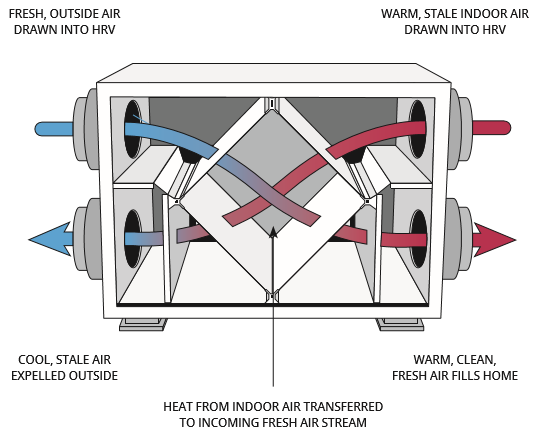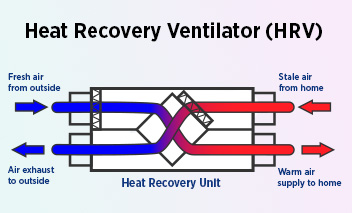Breaking Down HRV: A Step-by-Step Introduction
Wiki Article
The All-Inclusive Guide to the Uses of Heat Recovery Ventilation in Modern Buildings
Heat Recovery Ventilation (HRV) systems represent a substantial advancement in constructing technology (HRV Heat Recovery Ventilation). They give a method for trading stagnant interior air with fresh outdoor air while decreasing power loss. This strategy not just improves interior air top quality yet additionally contributes to power efficiency in both residential and industrial structures. Understanding the various applications and benefits of HRV can disclose its critical role in modern-day design and sustainability initiatives. The ramifications of this technology deserve checking out furtherUnderstanding Heat Recovery Ventilation Solutions

Several contemporary buildings prioritize power effectiveness, understanding warm recuperation ventilation (HRV) systems is important for enhancing indoor air quality and minimizing energy consumption. HRV systems work by moving heat from stale indoor air to incoming fresh air, effectively keeping comfy interior temperatures while reducing energy loss. These systems contain a warmth exchanger, fans, and ductwork that assist in the blood circulation of air. Throughout winter months, HRV systems record and recycle heat from the outbound air, while in summer season, they can aid cool inbound air. By continually trading air, HRV systems also minimize moisture and the concentration of interior contaminants. Correct setup and maintenance of HRV systems are essential for their efficiency and effectiveness in enhancing total building performance and convenience.
Advantages of Heat Recovery Ventilation
Heat recovery ventilation systems offer various advantages that improve both power efficiency and indoor air quality in modern-day buildings. By catching and reusing power from exhaust air, these systems greatly decrease heating & cooling expenses, resulting in reduced power consumption. They maintain a constant circulation of fresh exterior air, reducing the threat of indoor air toxins and irritants. This continual exchange aids regulate humidity degrees, stopping mold and mildew growth and making sure a healthier living atmosphere. In addition, HRV systems add to sustainability objectives by decreasing total carbon impacts. Their capability to maximize air flow without giving up thermal comfort makes them a useful addition to modern building style, promoting both financial and eco-friendly benefits.Applications of HRV in Residential Buildings
As home owners increasingly focus on power effectiveness and interior air high quality, the applications of warm healing air flow (HRV) systems in domestic structures have actually become much more widespread. HRV systems are specifically advantageous in tightly sealed homes, where keeping fresh air flow is necessary for protecting against wetness buildup and indoor toxins. They effectively move warm from outward bound stagnant air to inbound fresh air, lowering power prices linked with home heating and cooling. Additionally, HRVs can boost convenience degrees by managing humidity and temperature level. They are additionally adaptable for different household styles, consisting of single-family homes and multi-unit buildings. Overall, integrating HRV systems sustains sustainable living techniques while making sure a healthier indoor setting for occupants.HRV in Commercial and Commercial Setups
In industrial and commercial setups, the execution of warm recuperation ventilation (HRV) systems has come to be increasingly crucial for optimizing energy performance and maintaining air high quality. These systems efficiently move warm from exhaust air to inbound fresh air, reducing the requirement for extra home heating or cooling. This not only decreases energy prices but additionally adds to sustainability campaigns. Industries Check Out Your URL such as manufacturing, warehousing, and office complex benefit considerably from HRV systems, as they aid regulate temperature level and moisture levels, guaranteeing a comfy and effective setting. Furthermore, HRV systems help in getting rid of pollutants and excess moisture, boosting interior air top quality. As guidelines around air high quality come to be helpful hints more stringent, the adoption of HRV modern technology is most likely to grow, making it a vital component of contemporary business and commercial facilities.Future Fads in Heat Recovery Ventilation Innovation

Regularly Asked Concerns
How Does Heat Recovery Ventilation Impact Indoor Air High Quality?
Heat recovery ventilation substantially enhances interior air high quality by continually trading stagnant indoor air with fresh outside air while recovering power. This process decreases toxins, maintains optimal moisture levels, and guarantees a much healthier atmosphere for residents.Can HRV Equipments Be Set Up in Existing Buildings?
HRV systems can indeed be mounted in existing structures. Retrofitting might require alterations to ductwork and air flow designs, however it significantly improves energy efficiency and interior air top quality, making it a sensible alternative for older structures.What Upkeep Is Needed for HRV Systems?

Exist Particular Climates Where HRV Is Extra Reliable?
Heat recovery ventilation systems are specifically reliable in climates with considerable temperature distinctions between seasons. These systems maximize energy my site effectiveness by recuperating heat from exhaust air, making them ideal for both cold and moderately cozy settings.Just How Do HRV Systems Affect Energy Bills?

Report this wiki page